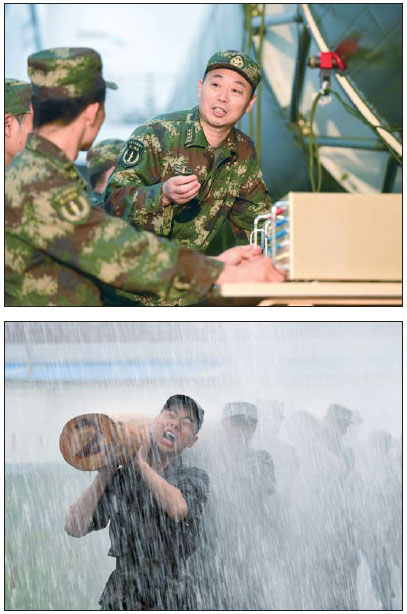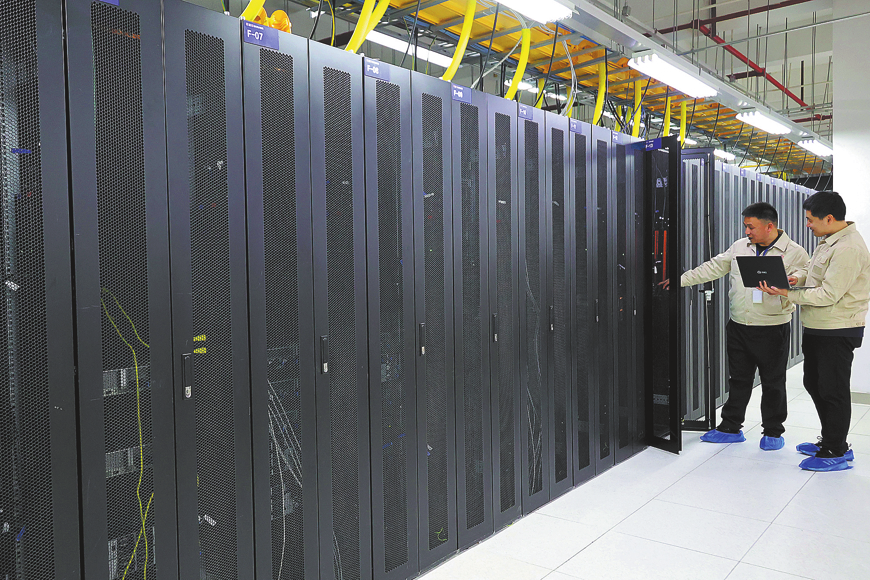Missile drills to prepare revamped fighting force

A series of drills has been held since the start of the new year to hone the combat readiness of the newly established PLA Rocket Force, according to reports by China Central Television, the state broadcasters.
Ballistic missile units under the force conducted war games with an "enemy force" in snow-covered Northeast China over the year's first weekend, footage showed.
The PLA Rocket Force was formed on Dec 31 to replace the PLA Second Artillery Corps and to manage China's ground-to-ground missile arsenal.
| (Top) Liu Lianjun, a senior engineer at an intercontinental ballistic missile brigade of the PLA Second Artillery Force, now the PLA Rocket Force, discusses technical problems with his fellow officers at their base in this photo taken on June 6. Song Bo / Xinhua (above) soldiers from the brigade test their strength during physical training in this June 16 photo. He Xiqing / Xinhua |
The CCTV footage featured the DF-21 medium-range ballistic missile being operated by soldiers, with units carrying out more than 10 maneuvers.
At the same time, another missile brigade staged a drill in Northwest China that involved simulated target-setting and multiple launches of short-range ballistic missiles, according to CCTV.
According to PLA Daily, the military's official newspaper, the rocket force has at least nine types of missiles in active service. They include the DF-5B intercontinental nuclear missile, the DF-26 intermediate-range ballistic missile and the CJ-10A ground-launched cruise missile.
Seven of the nine types were displayed during the Sept 3 parade in Tian'anmen Square to mark the 70th anniversary of victory in the War of Resistance Against Japanese Aggression (1937-45) and World War II. Their appearance caused a global stir, as it confirmed the existence of the DF-21D and DF-26. According to experts, they are the only two ballistic missiles capable of sinking an aircraft carrier.
A military expert who asked not to be named says the rocket force is striving to improve its combat capability under "sophisticated electronic and information warfare scenarios".
In addition to advanced missiles, the PLA is also seeking to upgrade its naval hardware.
The nation is manufacturing its second aircraft carrier in the coastal city of Dalian, Liaoning province, according to Defense Ministry spokesman Yang Yujun.
The new carrier has been designed in China and will have a displacement of 50,000 metric tons, a conventional power system, and will carry domestically developed J-15 fighter jets and other ship-borne aircraft, he says, adding that the ship will use a ski jump mode for launching fixed-wing aircraft, the same as the Liaoning, China's first aircraft carrier.
Senior Captain Zhang Junshe at the PLA Naval Military Studies Research Institute says the new carrier will focus on military operations rather than training and technological experiments.
"We use the Liaoning to test the reliability and compatibility of systems on carriers, and to train personnel. The second carrier will mainly do what a genuine aircraft carrier is supposed to do: running combat patrols and delivering humanitarian aid," he says. "The PLA needs at least three aircraft carriers; when it does, one can be on duty, one can train personnel, and the third can receive maintenance."
The expert notes that the new carrier's three major systems - power and propulsion, electronic systems and weapons - will all be developed by China and will have better capabilities than those on the Liaoning.
He says China will consider developing a nuclear-powered aircraft carrier after it gains enough experience in operating such large vessels.
Chen Xuesong, a fellow researcher at the PLA Naval Military Studies Research Institute, says he believes the new carrier, which is being constructed in sections to be assembled later, will be a tough challenge for Chinese engineers.
"The new vessel will truly be the first time for us to design and build an aircraft carrier," he says. "Our engineers must make sure their structural design is good and guarantee the quality of the steel parts."
Beyond the second carrier, China is looking into a host of cutting-edge technologies that can be used with future vessels. China Shipbuilding Industry Corp, which is building the second carrier, has been researching nuclear-powered ships since 2013.
Du Wenlong, a senior researcher at the PLA Academy of Military Science, says it is likely the navy's next-generation aircraft carrier will be equipped with nuclear propulsion. China already has nuclear submarines that require highly sophisticated technologies and manufacturing capabilities, so developing a nuclear carrier will not be difficult, he says.
(China Daily European Weekly 01/08/2016 page16)
Today's Top News
- New engine powers cargo drone expansion
- China to boost intl cooperation on green tech
- Factory activity sees marginal improvement in November
- Venezuela slams US' 'colonial threat' on its airspace
- Xi: Strengthen cyberspace governance framework
- Takaichi must stop rubbing salt in wounds, retract Taiwan remarks































